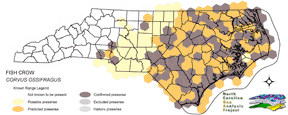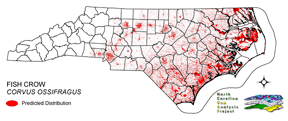
| Taxa: |
| Order: |
| Family: |
| Aves |
| Passeriformes |
| Corvidae |
| NatureServe Global Rank: |
| NatureServe State (NC) Rank: |
| G5 |
| S5B,S5N |
| Federal Status: |
| NC State Status: |
| --- |
| --- |


| Land Unit |
| US Fish & Wildlife Service |
| US Forest Service |
| US National Park Service |
| US Department of Defense |
| NC State Parks |
| NC University System |
| NC Wildlife Res. Com. |
| NC Forest Service |
| NC Div. of Coastal Mgmt. |
| Local Governments |
| Non-Governmental Org. |
| Other Public Lands |
| Private Lands |
| GAP Status 1-2 |
| All Protected Lands |
| Statewide |
| Hectares |
| 122,738.76 |
| 44,675.19 |
| 62,845.92 |
| 12,948.66 |
| 15,932.25 |
| 20,704.23 |
| 66,914.19 |
| 6,926.67 |
| 9,827.10 |
| 732.42 |
| 20,227.14 |
| 764.28 |
| 1,579,686.57 |
| 242,460.72 |
| 382,757.49 |
| 1,964,923.38 |
| Acres |
| 303,294.02 |
| 110,394.78 |
| 155,295.62 |
| 31,996.83 |
| 39,369.44 |
| 51,161.26 |
| 165,348.53 |
| 17,116.17 |
| 24,283.29 |
| 1,809.85 |
| 49,982.34 |
| 1,888.58 |
| 3,903,489.76 |
| 599,133.37 |
| 945,814.17 |
| 4,855,430.47 |
| % of Dist. on |
| Prot. Lands |
| 32.1 % |
| 11.7 % |
| 15.9 % |
| 3.4 % |
| 4.2 % |
| 5.4 % |
| 17.4 % |
| 1.8 % |
| 2.6 % |
| 5.3 % |
| 5.3 % |
| 0.1 % |
| < 0.1 % |
| 63.3 % |
| ----- |
| ----- |
| % of Dist. on |
| All Lands |
| 6.2 % |
| 2.3 % |
| 3.2 % |
| 0.7 % |
| 0.8 % |
| 1.1 % |
| 3.4 % |
| 0.4 % |
| 0.5 % |
| < 0.1 % |
| 1.0 % |
| < 0.1 % |
| 80.4 % |
| 12.3 % |
| ----- |
| ----- |
|
Common on the barrier islands, coastal plain, present but less common in sandhills and piedmont (Fussell 1994, Hamel 1992). Found in a variety of habitats along the coast, including shoreline, marshes, estuaries, thickets, and woodlands (Hamel 1992, Kaufman 1996). Inland from the coast, the Fish Crow generally is found in large river drainages, although it may feed in woods or fields a few miles from water (Kaufman 1996). Hamel (1992) specifies viable inland habitats as lake shores, pinewoods, and occasionally in towns, residential or other urban areas. Fish crows nest in top of a conifer or deciduous tree, generally 20 to 80 above the ground (Ehrlich et al 1988, Harrison 1975). Sticks, twigs, and bark fibers usually make up the outer cup, while the lining can consist of pine needles, hair, grass, fibrous bark, roots, feathers, trash (Goodwin 1976, Ehrlich et al 1988, Harrison 1975). Forages mostly on the ground, but may also feed in shrubs and trees (Goodwin 1976, Hamel 1992). NATURE SERVE GLOBAL HABITAT COMMENTS: Beaches, bays, lagoons, inlets, swamps, near marshes, and, less frequently, deciduous or coniferous woodland. In inland situations, primarily in baldcypress swamps and along major watercourses; also garbage dumps and towns (McNair 1989). Nests in tree, usually high, but sometimes as low as 2 m (Harrison 1978). |
| Code | Name | Description | NC Natural Heritage Program Equivalent |
| 378 | Ocean Beaches | Open beach sand. | Upper Beach |
| 3 | Tidal Marsh | Fresh and brackish tidal marshes, including cord grass, wild rice, sawgrass and needlerush alliances. | Brackish Marsh, Interdune pond, Maritime wet grassland |
| 124 | Maritime Scrubs and Tidal Shrublands | Coastal shrubs including wax-myrtle, swamp rose, alder, yaupon, and greenbriar. | Maritime Shrubs, Salt Shrub |
| 375 | Hypersaline coastal salt flats | Tidal flats within salt marshes, including saltmeadow cordgrass or sea-purslane dominated alliances. | Salt Marsh |
| 372 | Interdune Herbaceous Wetlands | Dune swales with permanently flooded to intermittently exposed hydrology. Species composition depends on salinity and can include cut grass, spike-rush, mosquito fern, and hornwort. | Interdune Pond, Maritime Wet Grasslands |
| 371 | Maritime Grasslands | Dune grass community consisting of sea oats and beach grasses. | Dune grass, Maritime dry grassland |
| 121 | Maritime Pinelands | Loblolly forests and woodlands of the outer coastal plain. | Estuarine Fringe Loblolly Pine Forest |
| 17 | Maritime Forests and Hammocks | Maritime forests and woodlands dominated by live or sand laurel oak. Estuarine Fringe forests dominated by loblolly pine. | Coastal Fringe Evergreen Forest, Maritime Deciduous Forest, Maritime Deciduous Forest |
| 126 | Interdune Wooded Depression Swamp | Includes swamps dominated by sweetbay and swampbay or dogwood dominated forests. | Maritime Shrub Swamp, Maritime Swamp Forest |
| 173 | Coastal Plain Riverbank Shrubs | Shrub dominated riverbanks, commonly dominated by willows and/or alders. | Sand and Mud Bar |
| 50 | Coastal Plain Mixed Bottomland Forests | Includes forests dominated by a variety of hardwood species, including sweetgum, cottonwood, red maple. | Coastal Plain Bottomland Hardwood (in part), Coastal Plain Levee Forest |
| 49 | Coastal Plain Oak Bottomland Forest | Bottomland forests dominated by deciduous oak alliances. Oaks represented can include swamp chestnut, cherrybark, willow, and/or overcup oak. Inclusions of loblolly pine temporarily flooded forests occur in patches. Hydrology is temporarily to seasonally flooded. | Coastal Plain Bottomland Hardwoods (in part) blackwater subtype, brownwater subtype |
| 158 | Coastal Plain Nonriverine Wet Flat Forests | Loblolly pine - Atlantic white-cedar - red maple - swamp tupelo saturated forests as well as forests dominated by loblolly, sweetgum, and red maple in non-riverine flats. | Non-riverine Wet Hardwood Forest |
| 41 | Peatland Atlantic White-Cedar Forest | Dense stands of Atlantic white cedar with saturated hydrology. Can include swamp tupelo, red maple, and pond pines with a moderate shrub and herb layer. | Peatland Atlantic White-Cedar Forest |
| 15 | Seepage and Streamhead Swamps | Includes extensive peat flats in the coastal plain, dominated by swamp tupelo, maples, and Atlantic white cedar alliances. In the sandhills includes streamhead pond pine and bay forests alliances. Saturated hydrology. | Bay Forest, Small Depression Pocosin, Streamhead Atlantic White Cedar Forest, Streamhead Pocosins |
| 30 | Cypress-Gum Floodplain Forests | Swamps dominated by black or swamp tupelo with or without Taxodium. Seasonally to semi-permanently flooded hydrology. | Cypress-Gum Swamps |
| 78 | Pond-Cypress - Gum Swamps, Savannas and Lakeshores | Cypress dominated swamps and lakeshores. Can include bays dominated by pond cypress or shorelines of coastal plain lakes with a narrow band of cypress. | Non-riverine Swamp Forest, Natural Lakeshores (in part) |
| 385 | Oak Bottomland Forest and Swamp Forest | The swamp chestnut oak, cherrybark oak, shumard oak and sweetgum alliance is one representative. Other alliances are dominated by water, willow, and overcup oaks. Swamp forests can be dominated by sweetgum, red maple, and black gum being dominant. Loblolly can occur in combination with sweetgum and red maple, or with tulip poplar. Includes saturated and semi- to permanently flooded forests in the mountains. | Piedmont/Mountain Bottomland Forest, Piedmont/Mountain Swamp Forest |
| 87 | Pocosin Woodlands and Shrublands | Includes pond pine woodland, low pocosin and high pocosin shrub dominated areas. Canebrakes and bay forests may be present. | Pond Pine Woodlands, Peatland Canebrake, Small Depression Pocosin |
| 267 | Riverbank Shrublands | Riverside shrubs with temporarily flooded hydrologies. Found in the both the Mountains and Piedmont. Containing dominants such as smooth alder and a Carolina or black willows. | Sand and Mud Bar |
| 269 | Floodplain Wet Shrublands | Saturated shrublands of the Piedmont, includes buttonbush, swamp-loosestrife, decodon and alders. | Piedmont/mountain Semipermanent Impoundment |
| 384 | Piedmont/Mountain Mixed Bottomland Hardwood Forests | Includes temporarily to seasonally forests dominated by hardwood species. Hardwoods include sweetgum, red maple, sycamore which co-occur in a mosaic of bottomland and levee positions. Includes alluvial hardwood forests in the mountains. Hemlock and white pine may occur as inclusions, but are generally mapped separately. | Piedmont/Mountain Alluvial Forest, Piedmont/Mountain Levee Forest |
| 202 | Residential Urban | Includes vegetation interspersed in residential areas. Includes lawns, mixed species woodlots, and horticultural shrubs. Vegetation accounts for between 20 - 70% of the cover. | No equivalent |
| 203 | Urban Low-Intensity Developed | Highly developed areas with vegetation accounting for < 20% of the cover. | No equivalent |
| 204 | Urban High-Intensity Developed and Transportation Corridors | Highly developed areas including infrastructure such as roads, railroads. Vegetation represents < 20% of the cover. | No equivalent |
|
Bent, A.C. 1946. Life histories of North American jays, crows, and titmice. U.S. Natl. Mus. Bull. 191. Washington, D.C.
Hamel, P. B. 1992. The land manager's guide to the birds of the south. The Nature Conservancy, Chapel Hill, North Carolina. 367 pp + several appendices. Fussell, J.O. III. 1994. A birderís guide to coastal North Carolina. Chapel Hill and London: The University of North Carolina Press. Kaufman K. 1996. Lives of North American Birds. Boston, New York: Houghton Mifflin Company. McNair, D. B. 1989 (1987). Status and distribution of the fish crow in the Carolinas and Georgia. Oriole 52:28-45. Johnston, D. W. 1961. The biosystematics of American crows. Washington. 127 pp. Harrison, H.H. 1975. A field guide to bird's nests in the U.S. east of the Mississippi River. Houghton Mifflin Company, Boston, Massachusetts. 257 p. Harrison, C. 1978. A field guide to the nests, eggs and nestlings of North American birds. Collins, Cleveland, Ohio. Harrison, H.H. 1979. A field guide to western birds' nests. Houghton Mifflin Company, Boston. 279 pp. Terres, J.K. 1980. The Audubon Society encyclopedia of North American birds. Alfred A. Knopf, New York. American Ornithologists' Union (AOU), Committee on Classification and Nomenclature. 1983. Check-list of North American Birds. Sixth Edition. American Ornithologists' Union, Allen Press, Inc., Lawrence, Kansas. Goodwin, D. 1986. Crows of the world. Second edition. Univ. Washington Press. 300 pp. Ehrlich, P.R., D.S. Dobkin, and D. Wheye. 1988. The birder's handbook:a field guide to the natural history of North American birds. Simon and Shuster, Inc., New York. xxx + 785 pp. Droege, S., and J.R. Sauer. 1990. North American Breeding Bird Survey, annual summary, 1989. U.S. Fish and Wildlife Service, Biological Report 90(8). 22 pp. Goodwin, L.M. 1976. Environmental Assessment of Proposed Service Area Project. |
For more information please contact them at:
NC-GAP Analysis Project
Dept. of Zoology, NCSU
Campus Box 7617
Raleigh, NC 27695-7617
(919) 513-2853
www.basic.ncsu.edu/ncgap